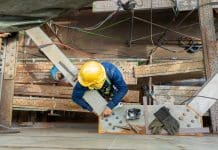Mark Robinson, group chief executive at leading public sector procurement authority SCAPE, looks at introducing mandatory whole-life carbon assessments for construction projects and explains why the looming recession cannot come at a cost to net zero
The construction industry has been at the forefront of UK growth for the best part of two years – leading the post-Covid recovery while overcoming the challenges posed by disrupted supply chains, rising input costs and labour shortages post-Brexit. As we head into the Winter though, it’s clear that the economic skies have begun to darken somewhat and created an air of uncertainty around projects. But, while the performance of the sector points to a challenging period ahead, we should remember that it is still well-placed to shape the outcomes of any slowdown. Perhaps, the most important of these outcomes should be maintaining the UK’s commitment and progress to net zero.
The history books repeatedly point to the construction industry’s propensity for triggering a race to the bottom on delivery contracts as economic conditions become frostier, squeezing margins with the supply chain as a result. I would argue that one of the more positive outcomes of the Covid-19 pandemic was that this didn’t become the case, despite the financial insecurity created by lockdown measures.
Investing in lower carbon design and materials
As we head into a potentially sustained recession, it’s important that clients and contractors draw on this spirit of long-termism – particularly in the public sector, which will be integral to driving improvement in the economy’s finances and stimulating much-needed green investment in local communities. Government and private developers alike will be rightly considering their capital expenditure costs in the coming months. However, in addressing immediate economic pressures, it is critical that they continue to invest in lower carbon design and materials to deliver rapid cost savings in operation.
From a practical perspective, this means maintaining the ambition to transition to a net zero public estate – prioritising the use of sustainable materials, designing out fossil fuels in heating systems and designing for energy efficiency despite higher up-front costs – in time to deliver on local and national climate targets.
Circular Twin project to digitally rebuild an existing school
Last year, we worked with Morgan Sindall Construction, HLM Architects, engineering consultancy Cundall and Lungfish Architects to highlight how a carbon-first approach to design and development can improve a project’s lifecycle performance and cost. The landmark project, known as ‘Circular Twin’, involved digitally rebuilding an existing school – originally completed in 2017 – from start to finish, with each design decision made to prioritise the lowest carbon outcome achievable.
The new version of the school, which maintained the educational design standards required by government, achieved a 67% reduction in whole-life carbon and a 72% reduction in upfront embodied carbon using market-ready products and materials. The school’s annual energy consumption was also modelled to be halved, paying back the increased upfront outlay in less than six years. With inflation in energy prices currently running ahead of the cost of construction products, the return on investment is improving by the week.
Mandating whole-life cost and carbon assessments for construction projects as a statutory requirement
The outcomes of the project formed part of an argument we put to government – with the backing of our delivery partners – that it should begin mandating whole-life cost and carbon assessments for construction as a statutory requirement when planning new-build and refurbishment projects in the public sector. By adopting green principles, the project proved that higher capex on sustainable projects can be outweighed by longer term opex savings if developers are able to adopt a long-term approach to funding.
In June, we saw a bill on whole-life reporting enter the early stages of parliamentary review and, following good progress on standards being made through the Construction Playbook and the inbound Procurement Bill, it’s something we hope to see the next Construction Minister run with.
In the meantime, the balancing act between capex and opex is a consideration that will continue to be made at a local level. Heading into a downturn, it’s important to recognise that compromises will need to be reached to ensure projects are budgeted and delivered effectively – with design and material choices a clear area for discussion. However, through innovation and effective project management – accompanied by a long-term view on ROI – it’s clear that we needn’t fall back on the road to net zero.
Mark Robinson

Group chief executive
SCAPE

















